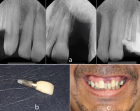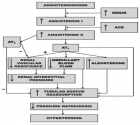Abstract
Case Report
Nursing Care of ICU Patients Lightly Sedated with Dexmedetomidine
Åsa Engström*, Maria Johansson, Mia Mattsson and Ulrica Strömbäck
Published: 22 December, 2016 | Volume 1 - Issue 1 | Pages: 005-013
Background: Intensive care patients are often in need of sedation to endure being intubated. Light sedation is increasingly common since it has been proved to offer benefits such as faster recovery to patients.
Aim: The aim of this study was to describe critical care nurses’ experiences of nursing patients lightly sedated with dexmedetomidine.
Research Methodology: Qualitative personal interviews were conducted during 2015 with 10 critical care nurses in Sweden. Interview transcripts were analysed using inductive qualitative thematic analysis.
Results: Light sedation of the patient facilitated communication and interaction with him or her, and the relationship between the patient and his or her family members. Dexmedetomidine was described as a fairly new drug, and the critical care nurses stated that they needed more knowledge about it and about sedation scales in order to learn more about the drug’s mechanism of action and its potential side effects on patients.
Conclusion: It is important to critical care nurses to learn more about dexmedetomidine and about sedation scales to assess levels of sedation, as light sedation has been shown to benefit the patient as opposed to deep sedation that can increase recovery time.
Read Full Article HTML DOI: 10.29328/journal.jcicm.1001002 Cite this Article Read Full Article PDF
Keywords:
Critical care nurses; Experiences; Intensive care; Qualitative content analysis; Sedation
References
- Hoy SM, Keating GM. Dexmedetomidine: A review of its use for sedation in mechanically ventilated patients in an intensive care setting and for procedural sedation. Drugs. 2011; 71: 1481-1501. Ref.: https://goo.gl/9RLMsb
- Aitken L, Marshall A, Chaboyer W. ACCCN's Critical Care Nursing. Elsevier Health Sciences. 2016. Ref.: https://goo.gl/J4tyT9
- Fullwood D, Sargent S. An overview of sedation for adult patients in hospital. Nurs Stand. 2010; 24: 48-56. Ref.: https://goo.gl/JK49gC
- Croxall C, Tyas M, Garside J. Sedation and its psychological effects following intensive care. Br J Nurs. 2014; 23: 800-804. Ref.: https://goo.gl/ZibH5p
- Makic MBF. Daily sedation interruption: current state of the science. Journal of Perianesth Nursing. 2014; 29: 501-503. Ref.: https://goo.gl/lYUUTo
- Dotson B. Daily interruption of sedation in patients treated with mechanical ventilation. Am J Health Syst Pharm. 67: 1002-1006. Ref.: https://goo.gl/vVkgtK
- Sessler C, Gosnell M, Grap M, Brophy G, O'Neal P, et al. The Richmond Agitation-Sedation Scale: Validity and reliability in adult intensive care unit patients. Am J Respir Crit Care Med. 2002; 166: 1338-1344. Ref.: https://goo.gl/tM0xcm
- Short J. Use of Dexmedetomine for primary sedation in a general intensive care unit. Crit Care Nurse. 2010; 30: 29-38. Ref.: https://goo.gl/3cK3k3
- Samuelson K, Lundberg D, Fridlund B. Stressful experiences in relation to depth of sedation in mechanically ventilated patients. Nurs Crit Care. 2007; 12: 93-104. Ref.: https://goo.gl/KMuwz9
- Engström Å, Nyström N, Sundelin G, Rattray J. People's experiences of being mechanically ventilated in an ICU: A qualitative study. Intensive Crit Care Nurs. 2013; 29: 88-95. Ref.: https://goo.gl/B2xvmM
- Egerod I, Christensen BV, Johansen L. Nurses’ and physicians’ sedation practices in Danish ICUs in 2003. A national survey. Intensive Crit Care Nurs. 2006; 22: 22-31. Ref.: https://goo.gl/5k70V7
- Walker N, Gillen P. Investigating nurses’ perceptions of their role in managing sedation in intensive care: An exploratory study. Intensive Crit Care Nurs. 2006; 22: 338-345. Ref.: https://goo.gl/hCg3OJ
- Barr J, Fraser GL, Puntillo K, Ely EW, Gélinas C, et al. Clinical practice guidelines for the management of pain, agitation, and delirium in adult patients in the intensive care unit. Crit Care Med. 2013; 41: 263-306. Ref.: https://goo.gl/70Gp3b
- Ely E, Truman B, Shintani A, Thomason J, Wheeler A, et al. Caring for the critically ill patient. Monitoring sedation status over time in ICU patients: Reliability and validity of the Richmond Agitation-Sedation Scale (RASS). JAMA. 2003; 289: 2983-2991. Ref.: https://goo.gl/Df6e7W
- Samuelson K. Sedation during mechanical ventilation in intensive care: Sedation practices and patients’ memories, stressful experiences and psychological distress. Doctoral diss, Lund University, Sweden. 2006. Ref.: https://goo.gl/WMMCrF
- Gerlach AT, Murphy CV, Dasta JF. An updated focused review of dexmedetomidine in adults. Ann Pharmacother. 2009; 43: 2064-2074. Ref.: https://goo.gl/hk3W8l
- Szumita PM, Baroletti SA, Anger KE, Wechsler ME. Sedation and analgesia in the intensive care unit: Evaluating the role of dexmedetomidine. Am J Health Syst Pharm. 2007; 64: 37-44. Ref.: https://goo.gl/fqwMa3
- Keating GM. Dexmedetomidine: a review of its use for sedation in the intensive care setting. Drugs. 2015; 75: 1119-1130. Ref.: https://goo.gl/zZZAXV
- Cruickshank M, Henderson L, MacLennan G, Fraser C, Campbell M, et al. Alpha-2 agonists for sedation of mechanically ventilated adults in intensive care units: a systematic review. Health Technol Assess. 2016; 20: 1-117. Ref.: https://goo.gl/PeBWlv
- FASS (Pharmaceutical Specialities in Sweden). Dexmedetomidine. Ref.: https://goo.gl/M0QqRc
- Patton MQ. Qualitative research & evaluation methods (4th ed.) London: SAGE. 2015.
- Polit DF, Beck CT. Nursing research: Generating and assessing evidence for nursing practice. (9th ed.) Philadelphia: Lippincott Williams and Wilkins. (2017). Ref.: https://goo.gl/Mh2XBH
- Kvale S, Brinkmann S. Den kvalitativa forskningsintervjun [The qualitative research interview]. 3th ed. Lund: Studentlitteratur. 2014. Ref.: https://goo.gl/CiMVcu
- SFS 2003:460. Svensk författningssamling [Swedish Code of Statutes]. Ref.: https://goo.gl/8lmX7c
- Roberts M, Johnson LA, Lalonde TL. Early mobility in the intensive care unit: Standard equipment vs a mobility platform. Am J Crit Care. 2014; 23: 451-457. Ref.: https://goo.gl/IMRNK9
- De Jonghe B, Bastuji-Garin S, Durand M, Malissin I, Rodrigues P, et al. Respiratory weakness is associated with limb weakness and delayed weaning in critical illness. Crit Care Med. 2007;35: 2007-2015. Ref.: https://goo.gl/SQ7biS
- Dasta J, Kane-Gill S, Pencina M, Shehabi Y, Bokesch P, et al. A cost-minimization analysis of dexmedetomidine compared with midazolam for long-term sedation in the intensive care unit. Crit Care Med. 2010;38: 497-503. Ref.: https://goo.gl/mO3KQw
- Shehabi Y, Bellomo R, Reade MC, Bailey M, Bass F, et al. Early goal-directed sedation versus standard sedation in mechanically ventilated critically ill patients: A pilot study. Crit Care Med. 2013; 41: 1983-1991. Ref.: https://goo.gl/eFkwdh
- Karlsson V. Att vårdas vaken med respirator: Patienters och närståendes upplevelser från en intensivvårdsavdelning [Being nursed awake with respiratory: Patients’ and their relatives’ experiences from an intensive care unit]. Doctoral thesis, University of Gothenburg, Sweden. 2012. Ref.: https://goo.gl/IW6eUH
- Laerkner E, Egerod C, Ploug H. Nurses’ experiences of caring for critically ill, non-sedated, mechanically ventilated patients in the Intensive Care Unit: A qualitative study. Intensive Crit Care Nurs. 2015; 31: 196-204. Ref.: https://goo.gl/ZxpTcq
- Eriksson K. Pausen: En beskrivning av vårdvetenskapens kunskapsobjekt [The pause: A description of health science knowledge objects]. Stockholm: Almqvist and Wiksell. 1987.
- Engström Å, Söderberg S. The experiences of partners of critically ill persons in an intensive care unit. Intensive Crit Care Nurs. 2004; 20: 299-308. Ref.: https://goo.gl/832YGc
- Pang P, Suen L. Stressors in the ICU: A comparison of patients’ and nurses’ perceptions. J Clin Nurs. 2008; 17: 2681-2689. Ref.: https://goo.gl/BSj8vE
- Tanios M, Epstein S, Grzeskowiak M, Nguyen HM, Hyunsoon P, et al. Influence of sedation strategies on unplanned extubation in a mixed intensive care unit. Am J Crit Care. 2014; 23: 306-315. Ref.: https://goo.gl/ZGqYTn
- Egerod I. Uncertain terms of sedation in ICU. How nurses and physicians manage and describe sedation for mechanically ventilated patients. J Clin Nurs. 2002; 11: 831-840. Ref.: https://goo.gl/eBjeaC
- Beck L, Johnson C. Implementation of a nurse-driven sedation protocol in the ICU. Dynamics. 2008; 19: 25-28. Ref.: https://goo.gl/vRydeu
- SFS 1982:763. Hälso- och sjukvårdslag [Swedish Health Care Act]. Ref.: https://goo.gl/fZDdG9
- SFS 2001:453. Hälso- och sjukvårdslag [Swedish Health Care Act]. Ref.: https://goo.gl/VAmtEV
Figures:
Similar Articles
-
Nursing Care of ICU Patients Lightly Sedated with DexmedetomidineÅsa Engström*,Maria Johansson,Mia Mattsson,Ulrica Strömbäck. Nursing Care of ICU Patients Lightly Sedated with Dexmedetomidine. . 2016 doi: 10.29328/journal.jcicm.1001002; 1: 005-013
-
Critical Management of Status EpilepticusFarahnaz Fallahian*,Seyed MohammadReza Hashemian*. Critical Management of Status Epilepticus. . 2017 doi: 10.29328/journal.jcicm.1001004; 2: 001-015
-
Update on Phenobarbital for Alcohol Withdrawal Syndrome in Intensive CareRukma Parthvi*,Parker Agne. Update on Phenobarbital for Alcohol Withdrawal Syndrome in Intensive Care. . 2019 doi: 10.29328/journal.jcicm.1001023; 4: 036-039
-
The continued relevance of Deep Brain Stimulation for chronic painSarah Marie Farrell,Tipu Aziz*. The continued relevance of Deep Brain Stimulation for chronic pain. . 2021 doi: 10.29328/journal.jcicm.1001034; 6: 009-014
-
An educational strategy for the implementation of a delirium assessment toolBeatriz Bonaga*,Elena Ruiz-Escribano Taravilla,Carmen Carrilero-López,María Dolores Castillo-Lag,Leanne M Boehm,Ángela Prado Mira,María Joaquina Piqueras Diaz,E Wesley Ely. An educational strategy for the implementation of a delirium assessment tool. . 2021 doi: 10.29328/journal.jcicm.1001035; 6: 015-020
-
Immunocompromised patients with SARS-CoV-2 infection in intensive care units, outcome and mortalityCynthia DENIS*,Hamid MERDJI,Mathieu BALDACINI,Maleka SCHENCK,Thierry ARTZNER,Yoann GRIMAUD,Thierry LAVIGNE,Ferhat MEZIANI,Vincent CASTELAIN,Raphaël CLERE-JEHL,Francis SCHNEIDER,Guillaume MOREL. Immunocompromised patients with SARS-CoV-2 infection in intensive care units, outcome and mortality. . 2021 doi: 10.29328/journal.jcicm.1001036; 6: 021-025
-
Case report: Perioperative management of a patient with familial dysautonomiaMelodie Sarebanha,Laura Valente,Minnea Kalra,A Joseph Layon,Ettore Crimi*. Case report: Perioperative management of a patient with familial dysautonomia. . 2021 doi: 10.29328/journal.jcicm.1001038; 6: 029-032
-
Tracheotomy in Severe Head Trauma: Early vs. LateNada Benabdelouahab*, Hajar Moujtahid, Larbi Aberouch, Jaouad Tadili, Ali Kettani, Mamoun Faroudy. Tracheotomy in Severe Head Trauma: Early vs. Late. . 2024 doi: 10.29328/journal.jcicm.1001045; 9: 001-004
Recently Viewed
-
Investigation of Stain Patterns from Diverse Blood Samples on Various SurfacesSonia Rajkumari*. Investigation of Stain Patterns from Diverse Blood Samples on Various Surfaces. J Forensic Sci Res. 2024: doi: 10.29328/journal.jfsr.1001061; 8: 028034
-
Needs in siblings of individuals with Down Syndrome and levels of coping Cali, ColombiaLina Fernanda Martínez Cadavid,Diana Marcela Gutiérrez Acosta,Luis Alexander Lovera Montilla*. Needs in siblings of individuals with Down Syndrome and levels of coping Cali, Colombia. J Adv Pediatr Child Health. 2021: doi: 10.29328/journal.japch.1001041; 4: 093-100
-
Non-surgical Treatment of Verrucous Hyperplasia on Amputation Stump: A Case Report and Literature ReviewSajeda Alnabelsi*, Reem Hasan, Hussein Abdallah, Suzan Qattini. Non-surgical Treatment of Verrucous Hyperplasia on Amputation Stump: A Case Report and Literature Review. Ann Dermatol Res. 2024: doi: 10.29328/journal.adr.1001034; 8: 015-017
-
Investigating Anti-Bacterial and Anti-COVID-19 Virus Properties and Mode of Action of Pure Mg(OH)2 and Copper-infused Mg(OH)2 Nanoparticles and Coated Polypropylene SurfacesSaleh Alkarri*, Melinda Frame, John Cairney, Lee Maddan, Jin H Kim, Jonathan O Rayner. Investigating Anti-Bacterial and Anti-COVID-19 Virus Properties and Mode of Action of Pure Mg(OH)2 and Copper-infused Mg(OH)2 Nanoparticles and Coated Polypropylene Surfaces. Int J Clin Virol. 2024: doi: 10.29328/journal.ijcv.1001057; 8: 008-023
-
A Low-cost High-throughput Targeted Sequencing for the Accurate Detection of Respiratory Tract PathogenChangyan Ju, Chengbosen Zhou, Zhezhi Deng, Jingwei Gao, Weizhao Jiang, Hanbing Zeng, Haiwei Huang, Yongxiang Duan, David X Deng*. A Low-cost High-throughput Targeted Sequencing for the Accurate Detection of Respiratory Tract Pathogen. Int J Clin Virol. 2024: doi: 10.29328/journal.ijcv.1001056; 8: 001-007
Most Viewed
-
Evaluation of Biostimulants Based on Recovered Protein Hydrolysates from Animal By-products as Plant Growth EnhancersH Pérez-Aguilar*, M Lacruz-Asaro, F Arán-Ais. Evaluation of Biostimulants Based on Recovered Protein Hydrolysates from Animal By-products as Plant Growth Enhancers. J Plant Sci Phytopathol. 2023 doi: 10.29328/journal.jpsp.1001104; 7: 042-047
-
Sinonasal Myxoma Extending into the Orbit in a 4-Year Old: A Case PresentationJulian A Purrinos*, Ramzi Younis. Sinonasal Myxoma Extending into the Orbit in a 4-Year Old: A Case Presentation. Arch Case Rep. 2024 doi: 10.29328/journal.acr.1001099; 8: 075-077
-
Feasibility study of magnetic sensing for detecting single-neuron action potentialsDenis Tonini,Kai Wu,Renata Saha,Jian-Ping Wang*. Feasibility study of magnetic sensing for detecting single-neuron action potentials. Ann Biomed Sci Eng. 2022 doi: 10.29328/journal.abse.1001018; 6: 019-029
-
Pediatric Dysgerminoma: Unveiling a Rare Ovarian TumorFaten Limaiem*, Khalil Saffar, Ahmed Halouani. Pediatric Dysgerminoma: Unveiling a Rare Ovarian Tumor. Arch Case Rep. 2024 doi: 10.29328/journal.acr.1001087; 8: 010-013
-
Physical activity can change the physiological and psychological circumstances during COVID-19 pandemic: A narrative reviewKhashayar Maroufi*. Physical activity can change the physiological and psychological circumstances during COVID-19 pandemic: A narrative review. J Sports Med Ther. 2021 doi: 10.29328/journal.jsmt.1001051; 6: 001-007

HSPI: We're glad you're here. Please click "create a new Query" if you are a new visitor to our website and need further information from us.
If you are already a member of our network and need to keep track of any developments regarding a question you have already submitted, click "take me to my Query."


















































































































































